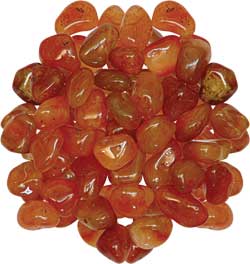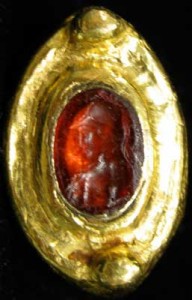Carnelian is a variety of chalcedony that often shows agate’s banding. It has a 6.5 to 7 hardness on the Mohs scale, making it a sturdy stone for jewelry use, and it was occasionally used to make marbles in the last century! It has a chemical composition of SiO2, which places it in the wide-ranging Quartz family of stone. It is a cryptocrystalline form of silica, composed of very fine inter-growths of the minerals quartz and morganite. It is colored by impurities of iron oxide, namely hematite. The color can vary greatly, ranging from pink, pale orange, to an intense almost-black coloration. When it occurs with black, white, and red bands it is called Sard or Sardonyx.
While the material from India is regarded as the finest, it is also found in several other places throughout the world including Africa, Australia, Brazil, Madagascar, Russia Uruguay, and the United States.
Carnelian has a long and distinguished history, being one of the 12 stones representing the twelve tribes of Israel set in the breastplate of the Jewish high priest in Biblical times. During Roman times it was often used make the engraved gems for signet or seal rings for imprinting a seal with wax on correspondence or other important documents. Hot wax does not stick to carnelian.
In Egypt, it was also highly popular. They believed the stone had great spiritual power, particularly with regard to the afterlife. It was routinely carved into a scarab and placed with the mummified dead because they thought that it would help to ensure a soul’s passage from the land of the living.
While widely used in both the East Indian and Pre-Columbian cultures for carving, jewelry, and trading, it is unknown to this author if it had any special metaphysical meaning or association in those cultures.
Metaphysically, Carnelian is said to awaken one’s talents and to produce inspiration from spiritual worlds. It was believed by the Romans to give the wearer courage in battle and to help timid speakers become eloquent and bold.
Melody states that it enhances analytical abilities and precision. Protecting against anger, fear, and rage, she says it helps to banish sorrow from the user. Pink carnelian is noted especially to be effective in fostering love and understanding between parents and children, and between parent and parent. It fosters compassion while dispelling apathy, indolence, and passivity. The orange variety is said to better focus the mind, especially during meditation.
She goes on to state that Carnelian, when used with chlorite and ruby crystals in troubled spaces are said to help dispel earthbound spirits and end hauntings!
Others believe this stone represents confidence, boldness, initiative, dramatic abilities, assertiveness and outgoingness. It encourages celebration and brings awareness of suppressed feelings. It is said to be an excellent stone for those recovering from childhood neglect.
This stone helps one feel anchored and comfortable with one’s surroundings. Carnelian provides a connection to the past or to historical events. It can improve motivation. This is why is is commonly believed to help one achieve greater success in career or personal matters.
Since it is believed to be a strong energy booster, it is ideal for those who wish to increase their overall vitality during illness. It is said to stimulate the will to live, help with mental focus and improve appetite.
Its association with the second Chakra also lends it to fertility work, helping to dispel sexual blocks, and it is said to strongly influence the reproductive organs. Additionally, it is used to help relieve painful menses and stimulate sexual passion. Not a bad stone to slip between the mattress and box spring!
In Feng Shui, Carnelian is used in the Center area for harmony and balance, in the South area for success, in the West area for creativity and in the Southeast area for self worth.
In other traditions, placing Carnelian near the front door is said to invoke protection and bring abundance to one’s home.
See you at the fair!


